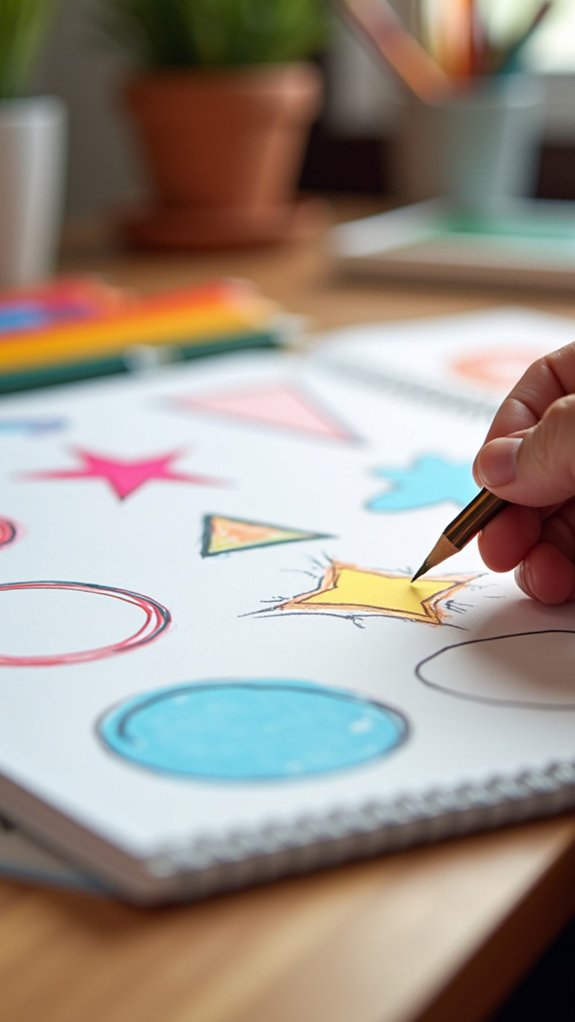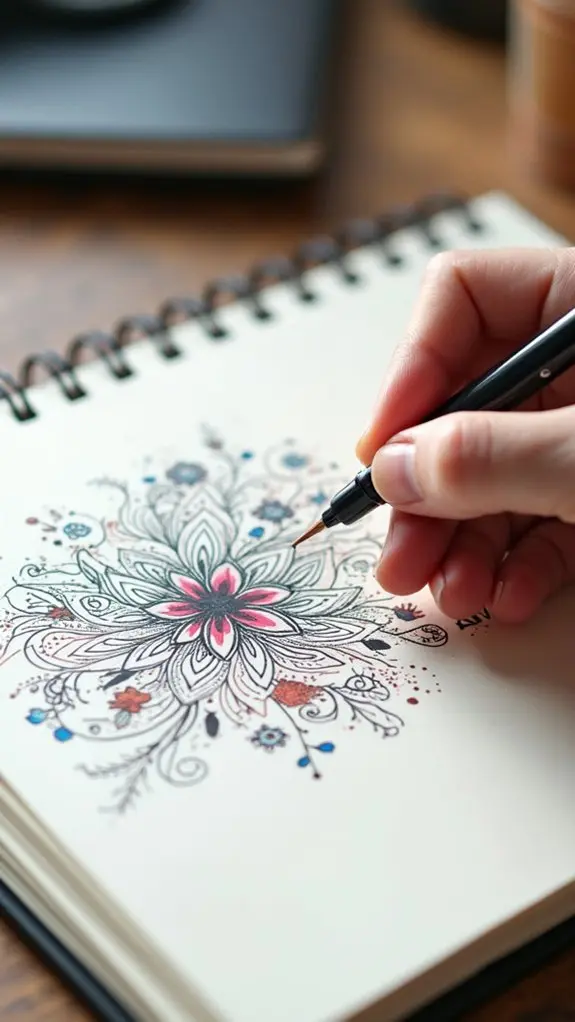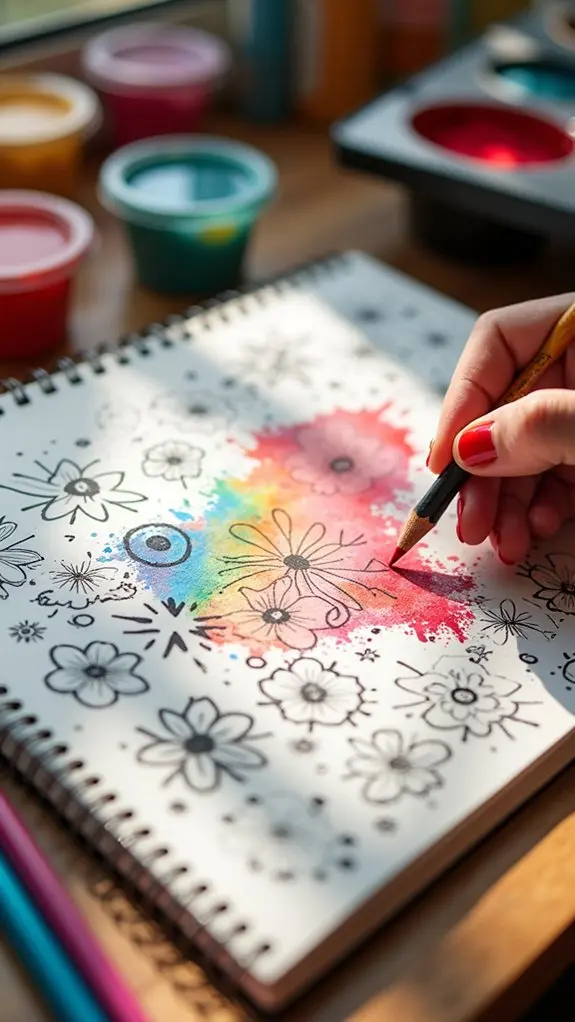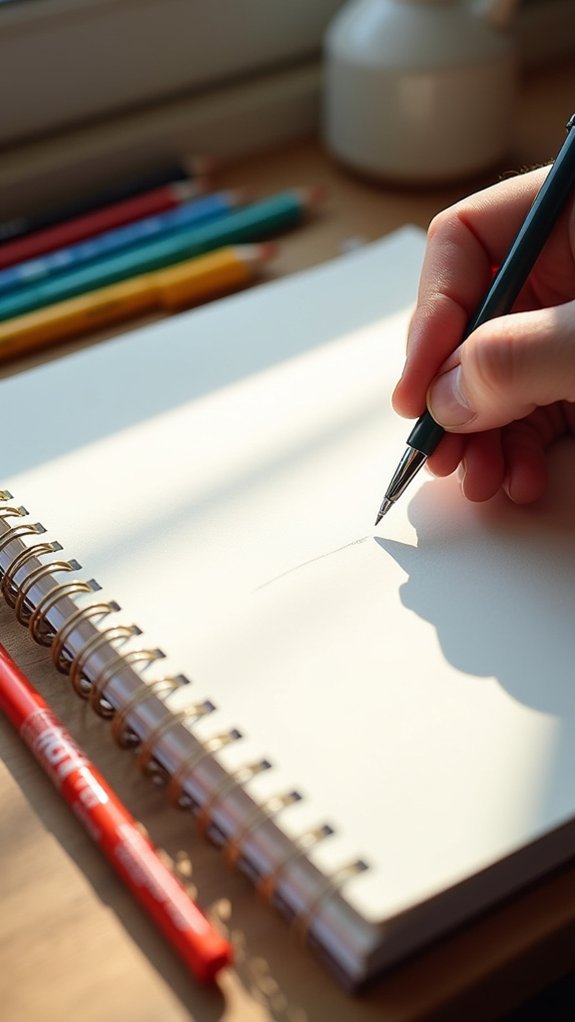Creating doodle art is all about having fun, not worrying about being perfect. Beginners start with a sketchbook, a pencil, and maybe some colorful pens or markers—nothing fancy! Warm up with basic shapes like circles and triangles, then turn everyday objects like mugs or fruit into simple doodles. Add patterns, bold outlines, and splash in bright colors to make the art pop. Doodling isn’t just for notebooks in class—there’s a lot more you can do if you stick around.
Key Takeaways
- Gather basic supplies like a sketchbook, pencil, fineline pens, markers, and colored pencils for versatility.
- Warm up by doodling simple shapes and lines to build confidence and hand control.
- Start drawing everyday objects by breaking them down into basic shapes and outlining key features.
- Create engaging patterns by repeating and varying shapes, sizes, and orientations to explore design possibilities.
- Outline your doodles with fine pens, add details, then enhance with texture, patterns, and vibrant colors.
Choosing Your Doodling Supplies
Before diving headfirst into a doodle explosion, every beginner needs to pick the right art supplies—think of it like packing the perfect bag for a wild adventure into the world of creativity.
The basics are simple: grab a sketchbook or plain paper and a trusty pencil to sketch out your first ideas. You’ll want pens next, especially black fineline ones with different nib sizes—they’re like magic wands for outlining.
Markers really up the fun level, with brands like Le Plume Permanent Markers making everything more colorful and bold. Or, if you’re into quieter vibes, colored pencils work great, too.
Don’t ignore nifty tools like stencils or circle makers! By mixing lots of supplies, beginner artists can experiment wildly and discover their own amazing doodling style.
Warming up With Simple Shapes

Every doodler, no matter how new they are, can take a lot of pressure off by starting with simple shapes—think of them as the doodle world’s training wheels.
Circles, squares, and triangles aren’t just boring—these shapes are actually your secret weapon for mastering curved lines and straight edges.
Try doodling ten circles in a row, then go wild with different sizes and combine shapes to see what you get. Sometimes, even a wonky rectangle has secret artistic potential!
Don’t shy away from playing with line thickness, either. A skinny triangle suddenly looks bold with a chunky outline.
Sitting down for regular shape warm-ups actually boosts muscle memory, and before you know it, your hand moves smoother and your confidence skyrockets.
Drawing Everyday Objects
Grab a pencil and get ready to look at ordinary things in a totally new way—drawing everyday objects turns the boring stuff around you into cool doodle adventures.
When doodles come alive, even a simple coffee cup gets interesting. Start by sketching an oval for the rim, and use a curved line to shape the body so it looks round and real. Add the handle with two big “C” shapes, and—boom!—you’ve got a cup.
Try doodling fruits or flowers next; just break them down into shapes, then use extra curved lines for leaves or petals. Mix up your line thickness to make objects pop.
Once you’re done, experiment with colors, giving your doodles some personality—coffee or apple red? You decide!
Creating Patterns and Motifs

Once someone’s had fun doodling stuff like mugs and apples, it’s time to level up and play around with patterns and motifs.
Patterns are all about repeating shapes, so start simple—a circle or triangle works, no need to get wild just yet! Try drawing your shape over and over, but switch up the size or turn it around. Suddenly, your pattern looks more like modern art and less like your math notes.
Motifs are like the coolest parts of patterns—the bits you make fancy with different lines, textures, and just a hint of your own weird style. Keep a sketchbook close and mash up shapes, lines, and even some bold colors.
With more practice, your doodles start to pop, and your motifs become totally you.
Outlining and Adding Details
Jumping into outlining is like giving your doodle a superhero suit—suddenly those random shapes and sketches start to look bold and important.
Using a fine liner pen, anyone can turn their basic designs into striking artwork that demands attention. When artists outline, they define the main shapes and features, making the doodle look sharp and purposeful. To seriously level things up, it helps to add details and experiment with line thickness, patterns, and textures.
Here’s a simple way to spice up the outlining and add details process:
- Outline primary shapes using steady, even lines for a clean look.
- Use thicker lines for main outlines and thinner lines for tiny details to add depth.
- Fill in sections with patterns, textures, or little embellishments to boost visual interest.
Bringing Your Doodles to Life With Color

Outlining and adding those awesome details definitely make a doodle stand out, but the real magic pops when color enters the picture.
First up, picking your color palette is like choosing your superhero team—it sets the vibe! Grab some bold markers like Le Plume Permanent for those super bright hits, or colored pencils when you want softer shading and more control.
Use different coloring techniques: try blending shades or fill shapes with wacky patterns to add doodles with depth and energy.
Here’s a pro move—outline doodled shapes with a thick black line before coloring. It makes the colors almost jump off the page!
Be fearless; mix and match colors and experiment with shifts between shades. Even the simplest doodle can come alive with creative color choices!
Structuring Your Doodle Layout

Even if a doodle starts with a wild idea, it needs some kind of structure to really shine—it’s like building a stage before the crazy dance-off begins.
Doodling helps organize thoughts and adds a cool flow, but you don’t have to rely on a straight line every time. Try these steps to shape up your doodle layout:
- Begin with a light cloud shape or a big circle in the center—think of this as your doodle’s comfy home base.
- Divide the page with spirals, swoopy lines, or more cloud shapes, sectioning off areas for different ideas or fun motifs.
- Overlap shapes and play with line thickness or shading so your sections pop, connect, and groove together.
That way, each doodle masterpiece feels connected yet totally unique!
Building Confidence and Finding Inspiration

It’s easy to feel nervous about your doodles, especially when that little voice in your head starts comparing them to someone else’s.
But confidence can sneak up on you if you just keep scribbling and remember that mistakes are honestly half the fun—nobody expects a masterpiece from a napkin doodle!
Inspiration is everywhere, too; sometimes it’s hiding in your messy backpack, out your window, or even scrolling past you on your phone.
Overcoming Artistic Self-Doubt
Self-doubt can sneak up on anyone, especially when someone is staring at a blank page, wondering if their doodles are “good enough.”
For beginners, it’s totally normal to feel nervous about making mistakes or worried about not having some secret, magical talent. Overcoming artistic self-doubt is about adding a little patience, courage, and self-kindness to your creative process.
Everyone starts somewhere different, so it’s important not to compare day one to someone else’s year ten. Here are a few ways to tackle those wobbly feelings:
- Keep a sketchbook to track doodle progress and watch your skills grow over time.
- Embrace mistakes because sometimes the “oops” moments create the coolest art.
- Join online art communities for support, fresh ideas, and gentle feedback.
Exploring Creative Inspiration Sources
Staring down those nerves is awesome, but sometimes the hardest part isn’t believing in yourself—it’s figuring out what to actually draw.
So, where do you start? One trick is to explore social media platforms like Instagram and Pinterest. These spots are jam-packed with other doodlers sharing wild, colorful ideas, and browsing them can seriously wake up your imagination.
If you’re feeling a little shy, you can join online communities made just for doodle fans. Post your drawings, get feedback, or just watch others doing their thing.
You could even plunge into doodle challenges or prompts—those can be goofy or super cool and really push you to try new stuff.
Plus, keeping a sketchbook to collect your favorite doodles helps track your creativity explosions!
Frequently Asked Questions
How Do I Make My Own Doodle Art?
Creating doodle art involves exploring doodle techniques, such as outlining shapes, varying line thickness, and adding patterns. By seeking creative inspiration from everyday objects and regularly practicing in a sketchbook, individuals develop personal style and confidence.
What Are the Shapes for Doodle Art for Beginners?
When considering basic doodle shapes for beginners, common options include circles, squares, and triangles, often combined to form simple doodle patterns. Incorporating swirls, curved lines, and experimenting with size helps create visually interesting and unique doodles.
What Are the Five Styles of Doodling?
When considering five styles of doodling, one finds zentangle for meditative patterns, doodle characters for whimsy, floral doodles for botanical flair, geometric forms for abstract doodles, and illustrative doodles blending whimsical patterns with creative storytelling.
How to Make Doodles for Kids?
When making doodles for kids, one can introduce simple shapes, doodle games, and creative prompts. Encouraging expressive faces, vibrant colors, and a playful approach helps children feel comfortable experimenting, boosting both their artistic confidence and enjoyment.
Conclusion
So, that’s how anyone can start making awesome doodle art—even if their best drawing right now is a stick figure with wild hair. With the right supplies, a little practice, and lots of imagination, doodle magic just happens. Sure, mistakes will sneak in, but honestly, that’s half the fun. The more someone doodles, the cooler their creations get. So why not grab some paper and just go for it? Who knows what new worlds will appear!


Leave a Reply